Welcome to the Winter Backpacking Trailhead
What is winter backpacking?
Winter backpacking is uniquely characterized by cold and snowy conditions. Comfort and safety during the winter depends on managing clothing, sleep, and shelter systems to protect you from cold temperatures, wind, and snow. In addition, winter backpacking often requires traction systems for stability on ice, or flotation in deep snow. Finally, winter backpacking involves different navigation and safety considerations than backpacking in other seasons, including the need to plan for longer days and shorter daylight hours and the increased probability of extreme weather conditions.

About this Trailhead
This article is one of Backpacking Light’s curated gateway pages (a trailhead, so to speak). Here, you’ll find information and resources about winter backpacking philosophy, gear, techniques, and more.
About this Trailhead: Curated and maintained by our staff, this Trailhead page includes an overview of the topic and links to information and resources on the Backpacking Light website. Those resources may consist of gear reviews, technology and testing, research, skills articles, online education (webinars, masterclasses, or other types of online courses), podcast episodes, forum threads, product recommendations, and other discovery tools, including our Gear Finder, Gear Shop, and Site Search engine.
Table of Contents • Note: some sections may only be available to Premium or Unlimited Members.
What are the benefits of winter backpacking?
There are several benefits to winter backpacking, including:
- Solitude: Many popular wilderness areas, national parks, and other hiking areas are less crowded in the winter, providing a quieter and more secluded outdoor experience.
- No Permits: Land management agencies that normally require difficult-to-acquire lottery-based or first-come-first-served backcountry permits in other seasons often lift permit requirements in the winter.
- Scenery: Winter can offer a unique and beautiful perspective on nature, with snow-covered landscapes, frozen waterfalls, and the perception of less human impact (e.g., trails and established campsites may be covered with snow).
- Camp Anywhere: Winter backpacking removes some of the constraints of finding durable surfaces for camping (a Leave No Trace practice) because the landscape is covered with snow.
- Challenge: Winter backpacking can be more challenging than backpacking in other seasons, due to the colder temperatures, harsher weather conditions, a higher level of skill requirements, and the increased physical effort required to carry more gear over snowy terrain.
- Insects and Bear Activity is Lower: In most locations, biting insects are not active during the winter and bears are hibernating.

What are the challenges of winter backpacking?
There are also several challenges to winter backpacking that must be overcome with different skills and gear strategies:
- Cold Temperatures: Lower temperatures require more careful management of clothing layering systems and sleep systems.
- Snow and Ice: Snow and ice requires traction or flotation devices in order to move efficiently.
- Limited Daylight: Later sunrises and earlier sunsets limit the amount of time you can travel safely, and longer nights place additional demands on sleep systems and clothing insulation.
- Heavier Pack Weight: Additional gear and supplies needed to survive in colder temperatures and safely travel across snow and ice add pack weight.
- Access to Water: Streams and lakes are often frozen, making access to water difficult.
- Avalanche Risk: Mountainous areas receiving heavy snowfall are prone to avalanches.
- Extreme Weather: Winter storms bring high winds, heavy snowfall, and low-visibility during blizzards which can make travel dangerous, progress slow, and navigation difficult.
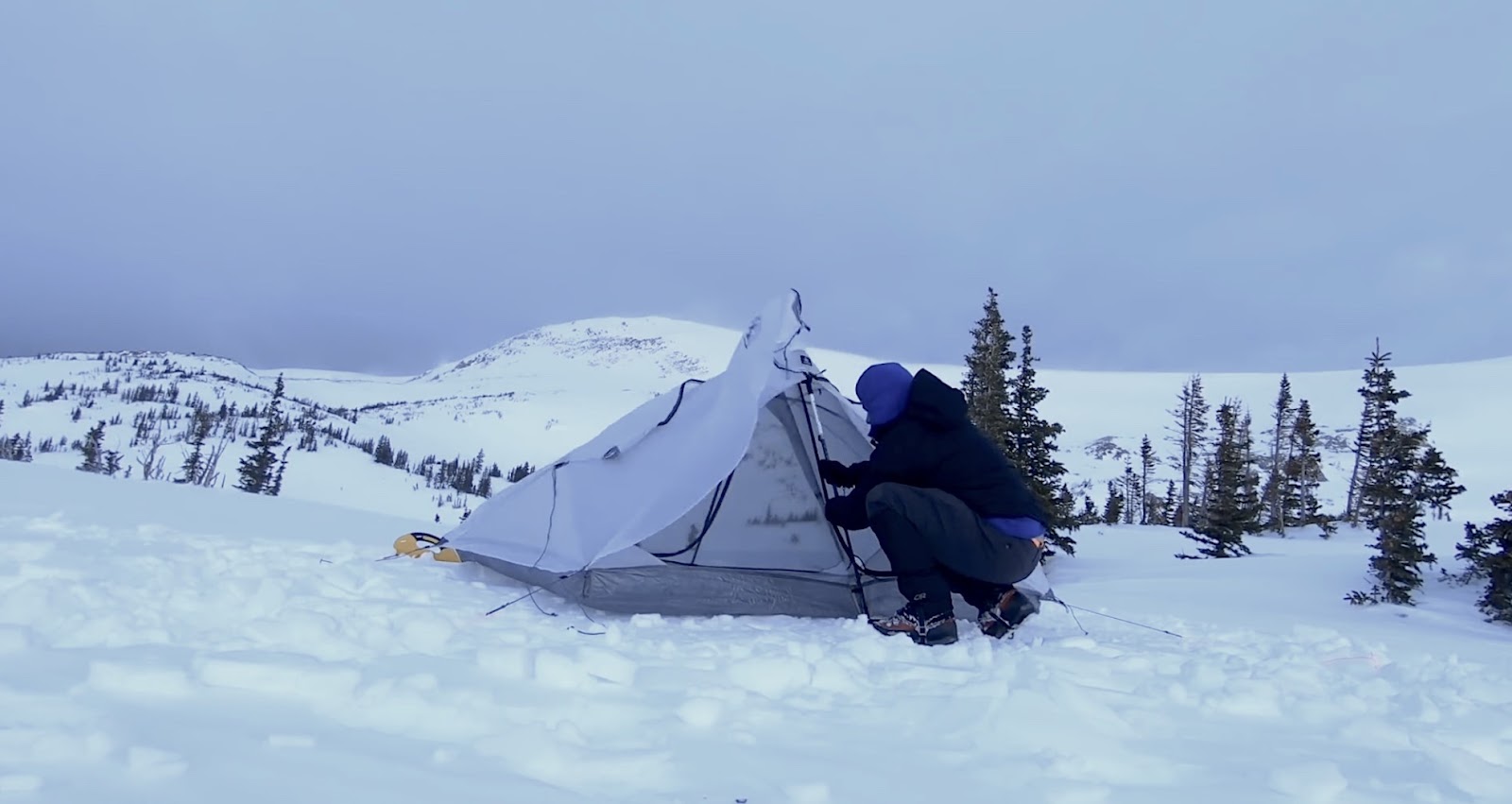
Winter Backpacking Strategy Depends on Snow Conditions
There is a big difference between winter backpacking on highly-trafficked, packed snow trail corridors and winter backpacking in deep powder snow. Each requires a slightly different set of skills and equipment. These two articles highlight the differences in gear lists between the two scenarios:
- Gear List: Winter Backpacking on Packed-Snow Trails
- Gear List: Winter Backpacking & Snowcave Camping in Deep Snow
Not all parts of the world are snowy during the winter months, but still experience very cold temperatures. This requires changes to your shelter, sleep, clothing, water, and cooking systems. This article presents some examples:
- Tips, Tricks, & Hacks: Winter Backpacking When There’s No Snow?

Winter Backpacking Gear
Overview
Here are some places to start to get a big picture view of winter gear vs. backpacking gear used the rest of the year:
- Podcast: Episode 8 | Winter Backpacking Skills and Gear
- Webinar: Winter Hiking & Backpacking Gear – Part 1
- Webinar: Winter Hiking & Backpacking Gear – Part 2
- Wilderness Skills: Lightweight Backpacking in the Winter: Gear and Techniques from the Arctic
Dealing with a Heavy Pack in the Winter
Winter backpacking requires more gear, and often heavier gear. For example, on multi-day treks in the Northern Rocky Mountains, nighttime temperatures can fall below zero degrees fahrenheit (-18 °C). This requires shelters that can withstand blizzard conditions in addition t0 other winter gear such as snowshoes or skis (and their repair kits). This makes winter base pack weights ranging from 15 to 25 pounds (7 to 12 kg), as opposed to common summer base pack weights in the same region of 10 to 15 pounds (4 to 7 kg).
As a result of these gear demands, a winter backpack needs a more robust suspension for carrying heavier loads and increased volume for carrying bulkier gear. To get you up to speed on how pack comfort is related to suspension performance, see:
- Technology: How Packs Work
- Testing: Quantitative Analysis of Backpack Suspension Performance
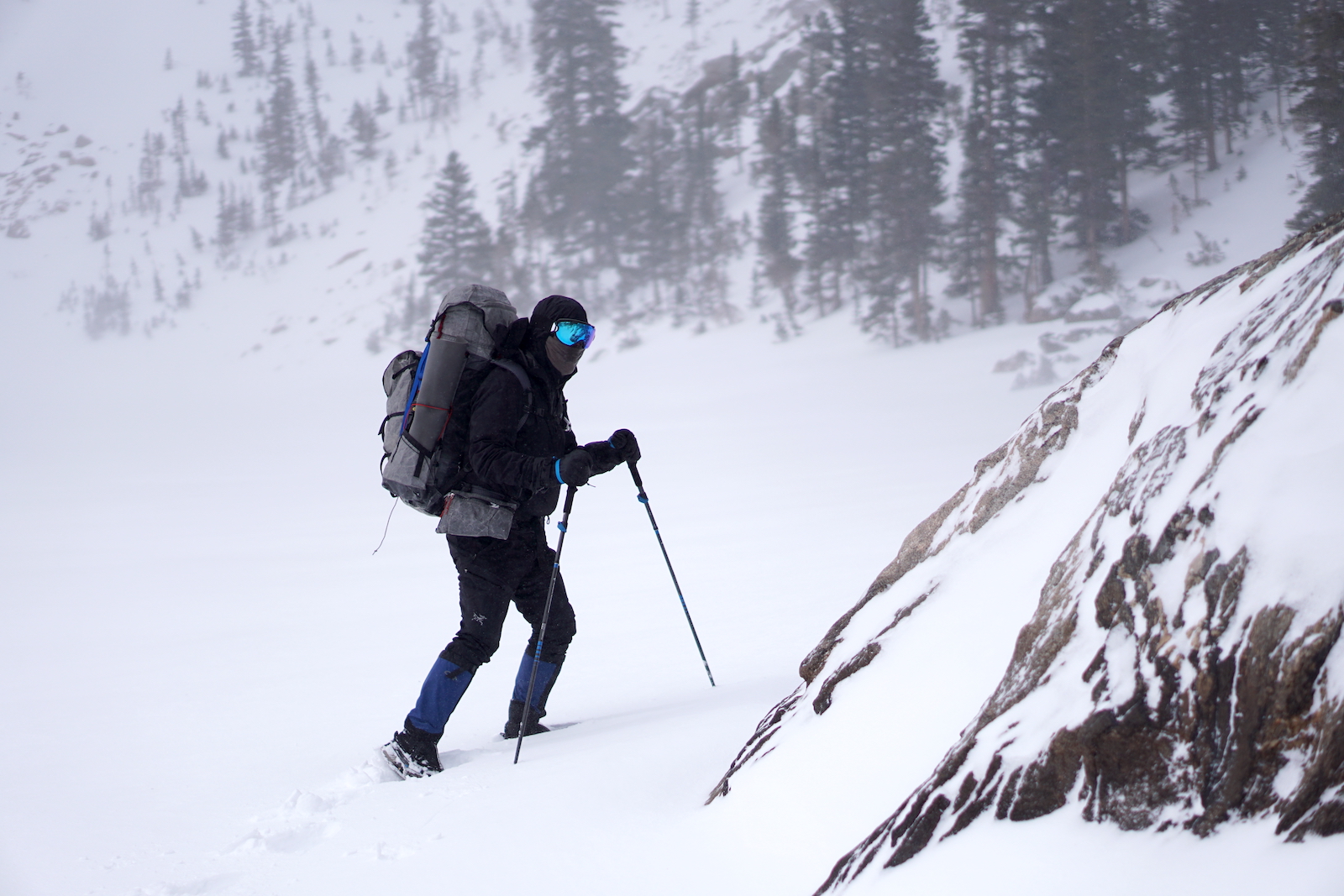
In addition, on low-angle terrain, pulling a pulk or sled may be easier – and allow you to carry more weight (luxury items!) for long winter nights! Learn more about pulks here:
- Forum: To Pulk or Not To Pulk
- Forum: Pulk/Sled for Winter Backpacking
- Make Your Own Gear: The Incredible Rulk (Pulk/Ruck Combo)
- Search: See more content about pulks

Layering for Winter Backpacking
Winter backpacking in cold temperatures requires unconventional approaches to layering if you want to save as much weight as possible and still be able to manage moisture and heat while hiking.
- Podcast: Episode 49 | Untraditional Layers
- Podcast: Episode 75 | Winter Layering for the Legs
- Podcast: Episode 76 | Vapor Barrier Gloves and Socks
- Gear Review: Brynje Thermo Mesh Review
- Webinar: Lightweight Clothing Layering Systems for Backpacking
- Webinar: Winter Backpacking: Strategies for Staying Warm, Dry, and Comfortable
- Wilderness Skills: Lightweight Backpacking Gear for Cold Winter Temperatures (Two-Layer Systems, Vapor Barriers, and Really Puffy Stuff)
Sleep Systems for Winter Backpacking
Some users prefer a full, winter-rated, down mummy sleeping bag for winter camping as opposed to one of the more frequent choices among lightweight backpackers – a quilt. However, there are some compelling reasons to think about a 2-layer quilt/bag system. The inner layer is typically a down bag or quilt, and the outer layer is typically a synthetic quilt or overbag, sized larger. The latter serves the purpose of moving the dew point out of the down bag and trapping condensation into the synthetic fill, where it has less negative impact than if it was trapped inside a down bag. Learn more:
- Podcast: Episode 71 | Sleeping Bag Layering Systems
- Forum: Temperature Ratings for Multiple Quilt Layers

Shelter Considerations for Winter Backpacking
Typical ultralight shelters (e.g., those supported by trekking poles) are neither comfortable nor safe to use above the treeline in a winter storm. Watch this case study to see what we mean:
- Trips/Video: Field Notes: Retreat from a Spring Alpine Storm
Ultralight shelters can, however, be used successfully in snowy but more sheltered locations or in mild weather conditions.
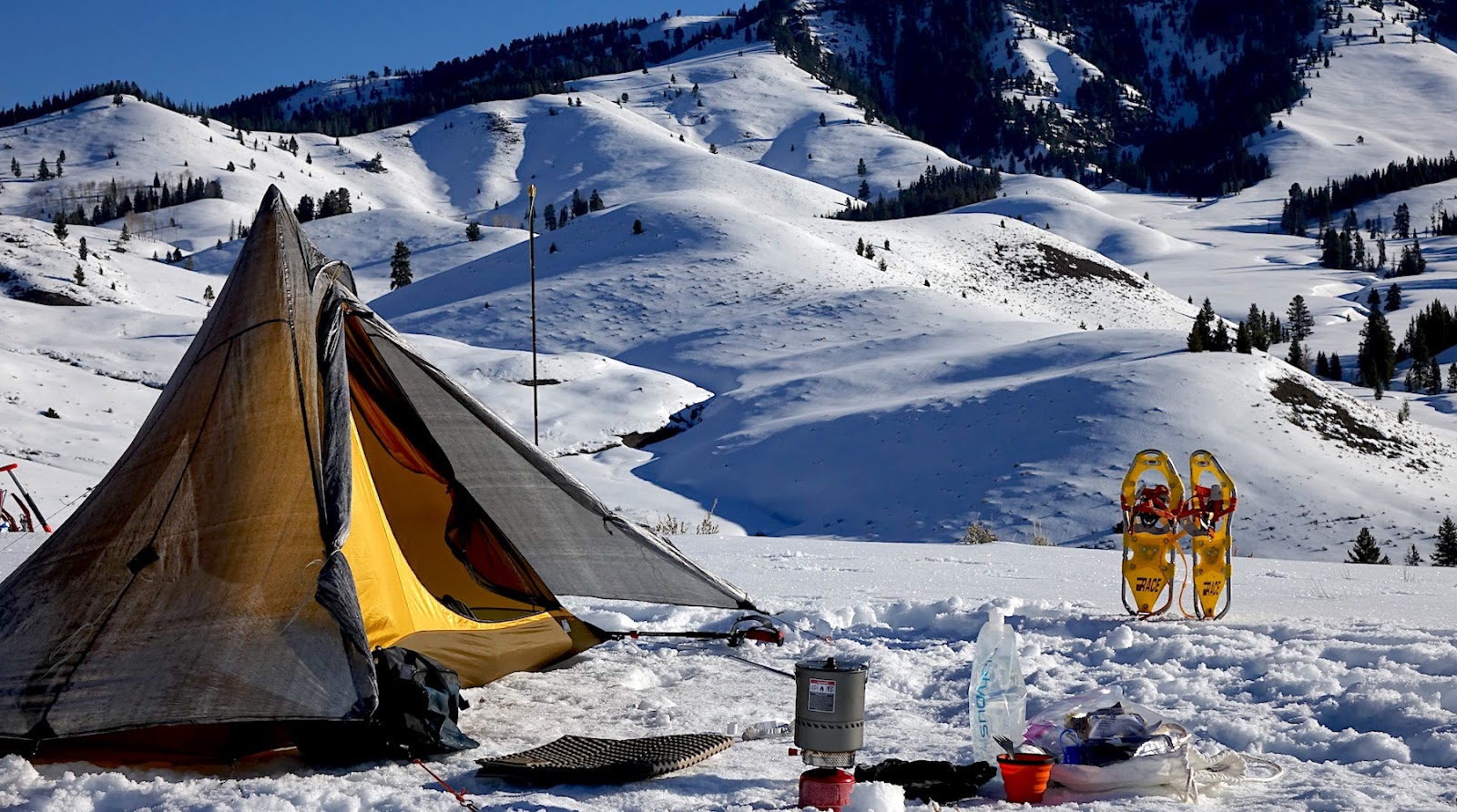
When extending an ultralight shelter into winter conditions, consider these challenges your shelter has to overcome:
- Wind-blown spindrift (light snow) entering your shelter through vents and gaps in the canopy.
- Snow-loading during blizzards.
- More condensation that inevitably accumulates in cold conditions.
- Wind and ventilation results in drafty conditions inside the tent.
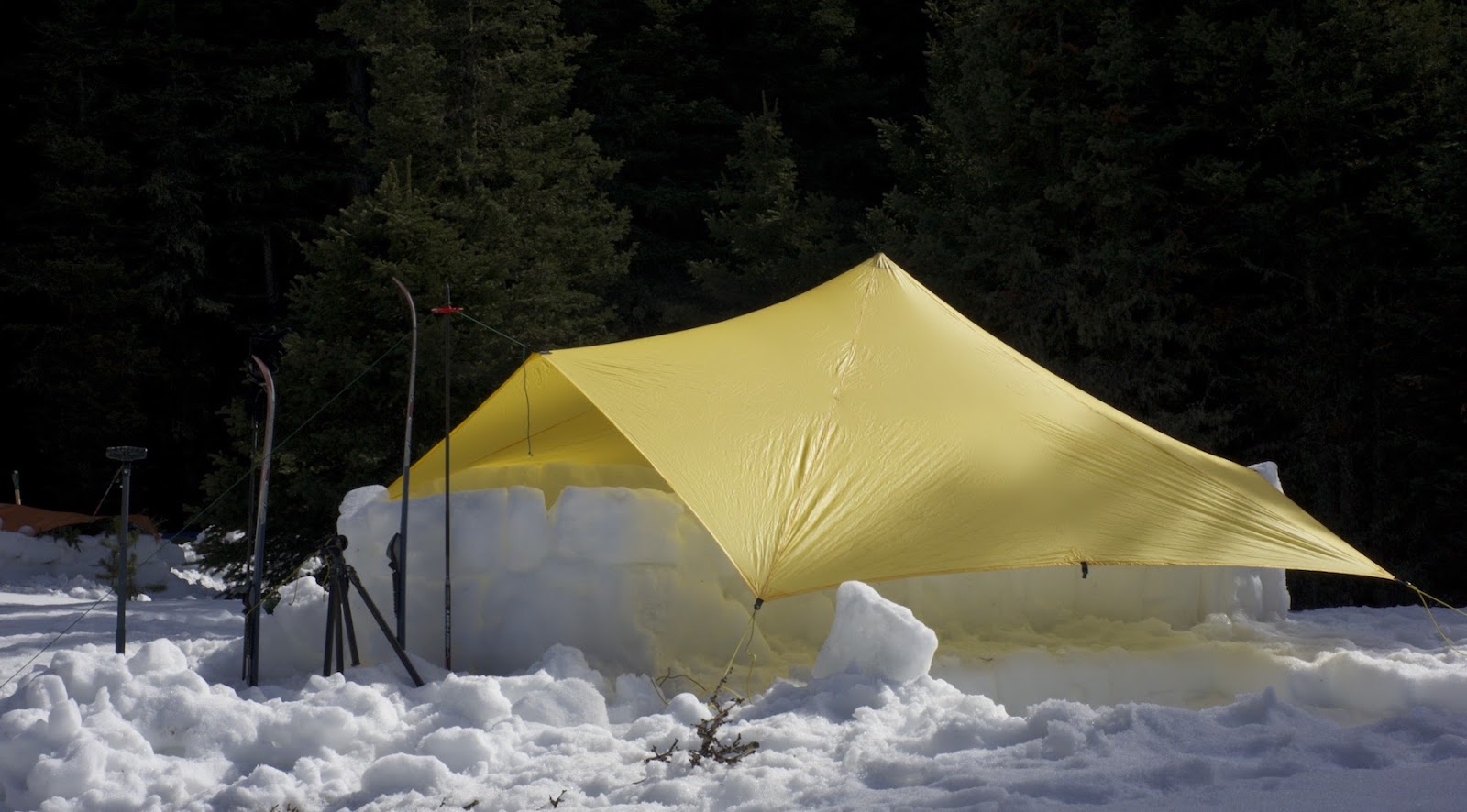
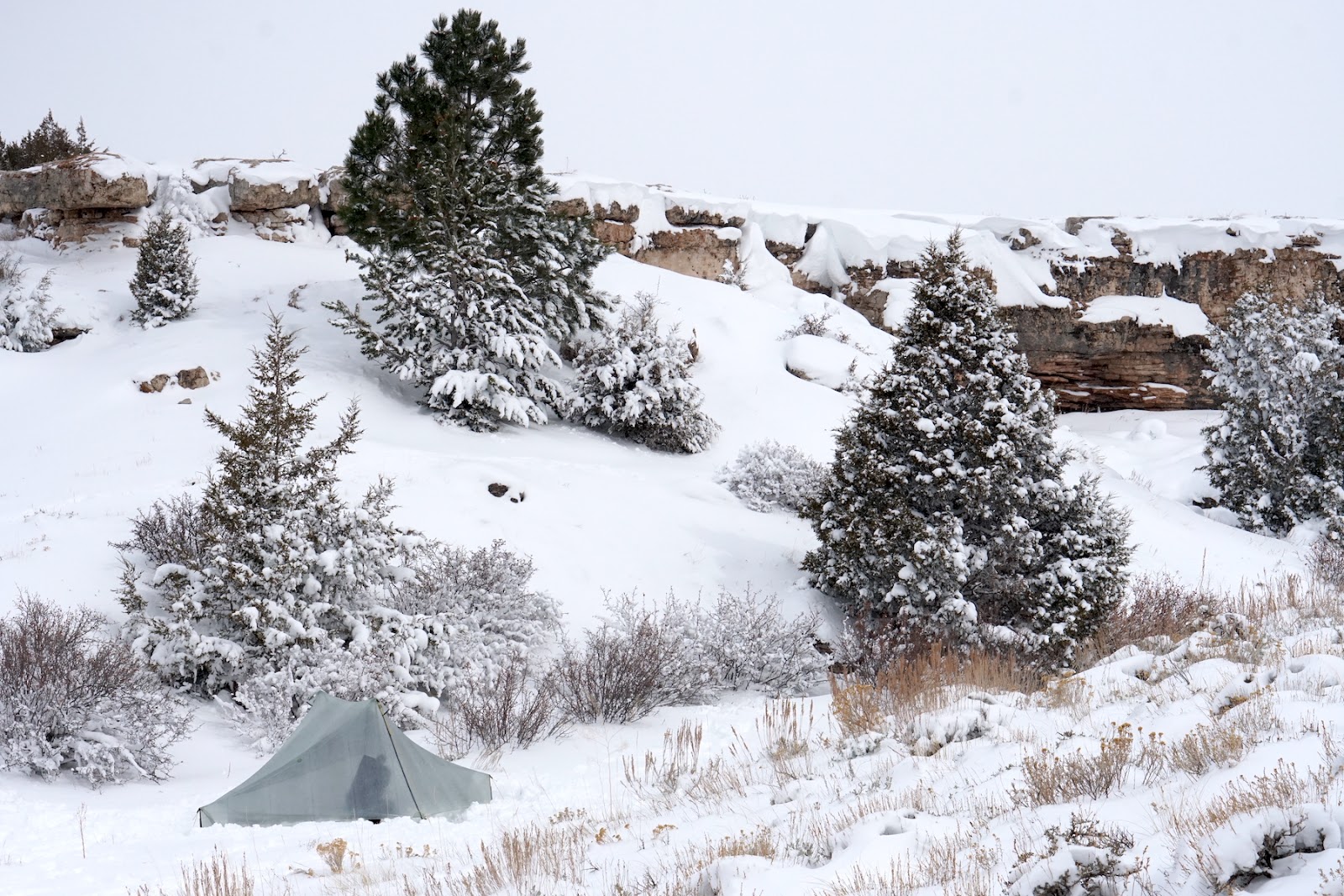
Spindrift can be mitigated by using a full-perimeter shelter, such as a pyramid shelter, where the edges come all the way to the ground (and can be sealed with snow), or by using a double-wall shelter with a solid-fabric inner tent (the latter of which also helps with condensation and wind drafts).
Snow loading resistance requires overhead structure, as one might find with a tent with geodesic arches.
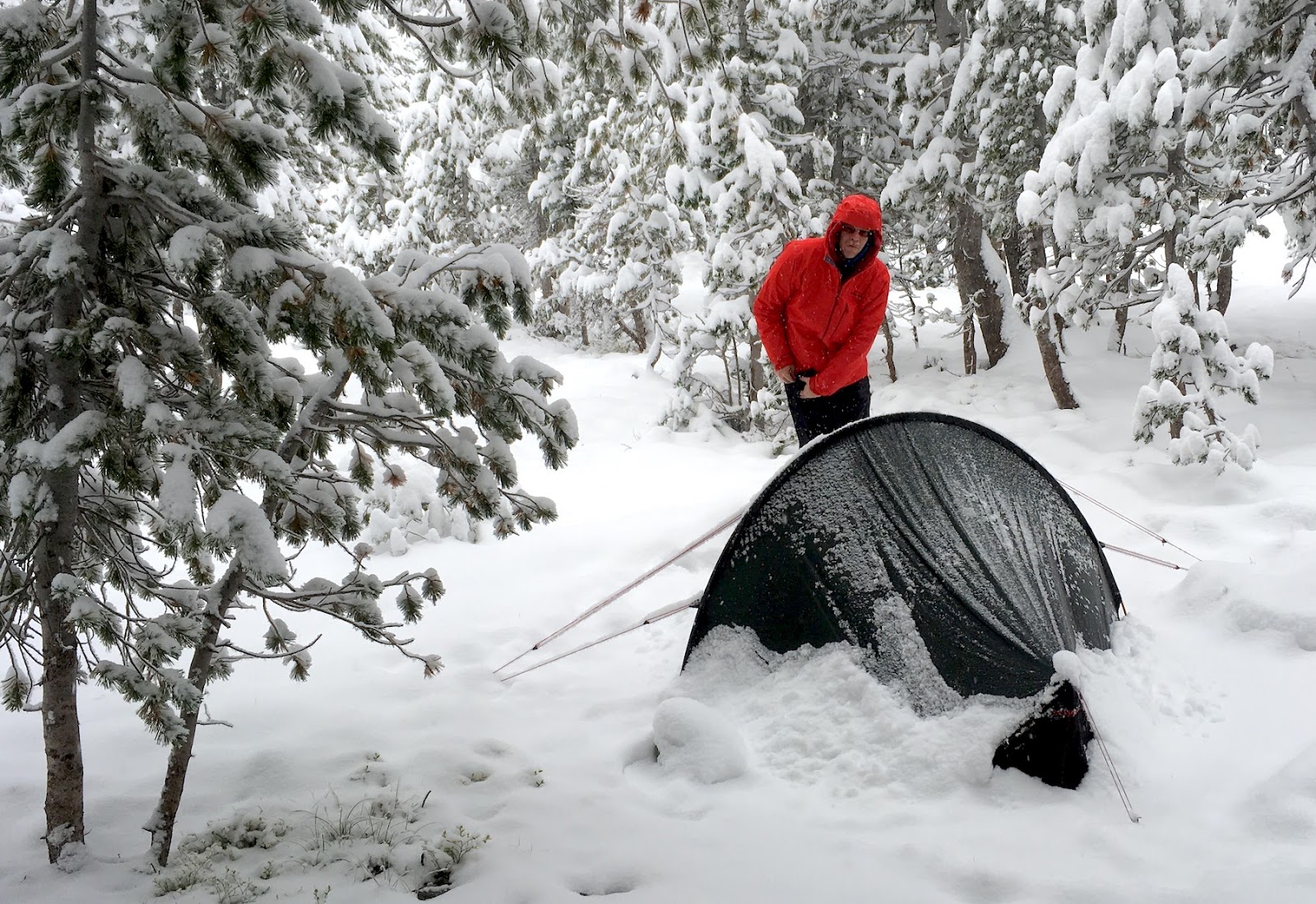
Also – consider stakes and guylines in the snow, which requires a different strategy!
- Forum: Understanding different types of winter shelters
- Wilderness Skills: Camping in the Snow
- Podcast: Shelter Stakes for Winter Camping
A tent with a wood stove is a luxurious home for winter camping:
- Gear Review: Seek Outside Tipi Review: An Ultralight Stove Tent for Cold Weather Backpacking with a Group
For more tips on dealing with accumulating condensation in your shelter:
- Podcast: Episode 83 | Shelter Condensation
And don’t forget about snow shelters, like igloos, caves, and quinzee huts.
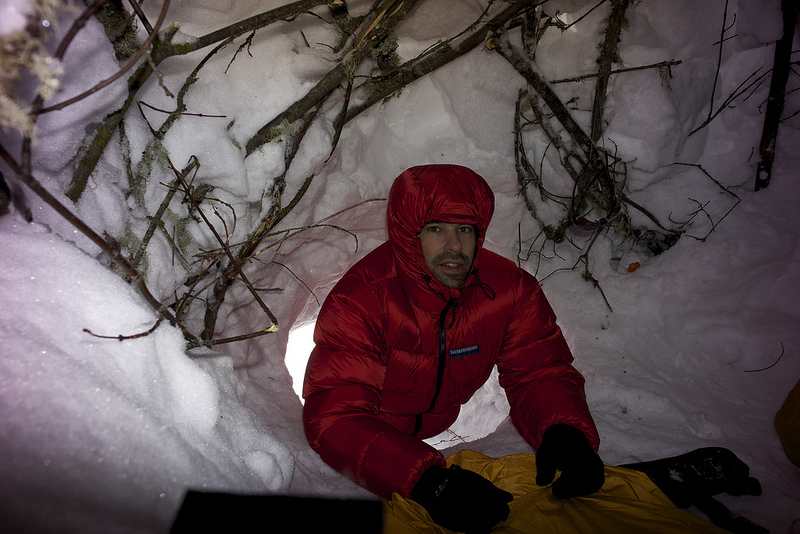
- Wilderness Skills: Igloo Building for Fun and Shelter, Part 1 – Technique
- Wilderness Skills: Igloo Building for Fun and Shelter, Part 2 – Using an Igloo as a Backcountry Shelter
- Wilderness Skills: Make Your Own Gear – Igloos
Staying in remote Forest Service cabins means you can lighten your pack and leave a tent at home, and instead enjoy the cozy and comfortable environment with a wood stove!
- Story: Winter Cabineering Part 1
- Skills and Gear: Winter Cabineering Part 2
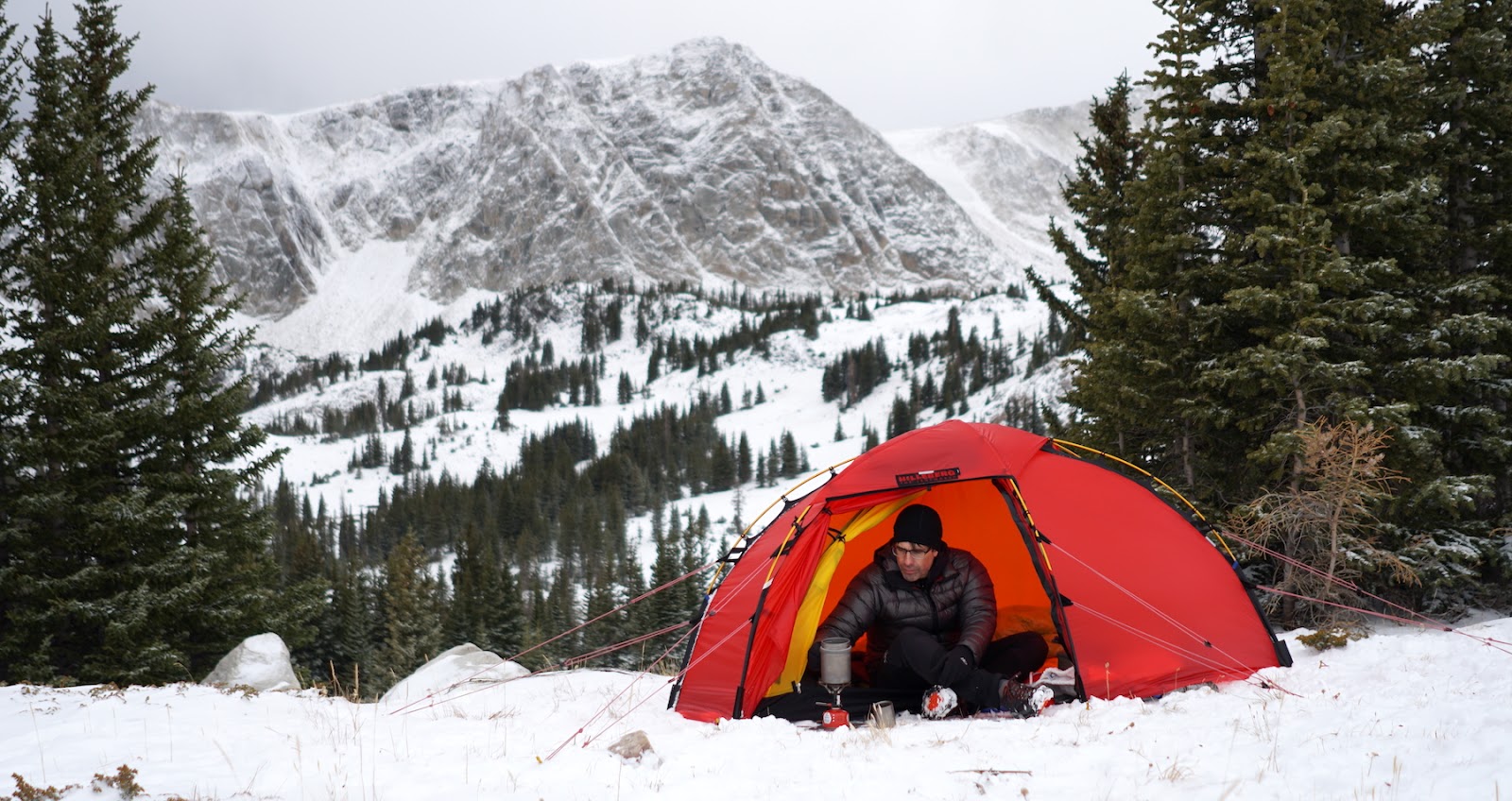
Footwear and Traction Systems
Winter backpacking creates many challenges for the ultralight hiker – cold and wet feet, flotation, and traction. Learn how to mitigate these challenges and stay comfortable in cold, snowy environments:
- Article: Backcountry Travel on Snowshoes for Lightweight Backpackers
- Webinar: Lightweight Footwear and Traction Systems for Snow Travel
- Wilderness Skills: Spring Footwear: Lightweight Overboot & High Gaiter Systems for Keeping Feet Warm & Dry

Winter Backpacking Stoves
Ultralight stoves using solid fuel and alcohol fuel can be used in the winter, but aren’t powerful enough to withstand blizzard conditions. Consider inverted canister (liquid-feed) stoves, which provide a good balance between power and weight when you need to melt snow for water.
- Skills: Be careful with stoves in tents (carbon monoxide poisoning)
- Forums: Using an alcohol stove in the winter
- Tech: Evolution of a Winter Stove
- Forum: Our community debates the best winter backpacking stove
- Gear: A wood-stove was successfully used on this late winter/early spring ski traverse of the John Muir Trail and here is a summary of wood fire cooking techniques
- Skills: Stove Systems for Winter Backpacking

Water Treatment and Transport
Narrow-mouth water bottles and hydration bladders tend to freeze in the winter. This can be mitigated a little by making a DIY cozy and/or inverting the water bottle in your pack (since water freezes from the top-down, ice won’t clog up the opening).
In the winter, surface water is not available, so melting snow may be your only option. That will increase your fuel requirements and stove power!
If you’re persistent, you may be able to find water where no snow exists on the ground:
- Forums & Skills: See our winter water challenge about how to extract water from a frozen stream covered by thick ice and how Ryan Jordan resolved it
Water filters are generally frowned on as unreliable in the winter because water can turn to ice in the pores. In some cases, that freezing could cause the filter to crack and fail. If you carry a water filter in the winter, keep it warm inside your jacket while hiking and in camp, and in your sleeping bag at night.
Chemical treatment is reliable, but because of cold temperatures, consider doubling the treatment time. Ultraviolet (UV) pens work well, but cold temperatures rapidly drain batteries.
Melting snow and boiling water is still the most common method of water production and treatment in cold and snowy environments.

More Winter Backpacking Skills
Avalanche Awareness, Safety, Skills & Equipment
Winter hikers should be aware of avalanche risk when venturing into the backcountry. An avalanche is a mass of snow, ice, and debris that can be triggered by natural factors such as heavy snowfall or weak snow layers in the snowpack. Avalanches are often triggered by humans because of the extra weight they place on a weak snowpack. Hikers and backpackers can trigger avalanches even when they aren’t traversing the steepest parts of avalanche-prone slopes. Winter hikers and backpackers who travel in avalanche-prone areas should do so in a group, with all of them armed with current avalanche forecast information, avalanche safety and rescue skills, and the proper gear – including an avalanche transceiver, shovel, and probe.
- Podcast: Episode 73 | Avalanche Awareness for Backpackers
- Webinar: Avalanche Awareness & Safety for Hikers and Backpackers
Winter Backpacking Food Considerations
During the winter, you have some limitations in what type of food you can bring. Higher water content foods can freeze, and make poor choices for cold snacks because they are difficult to eat. On the other hand, because of low temperatures in the winter, foods that normally spoil in the summer can be safely packed on multi-day winter trips. These include cheeses, pre-made sauces, fresh breads and tortillas, vegetables, and condiments like mayonnaise.
Winter backpacking requires more energy, so you may be packing more food weight to get the extra calories.
In addition, if you’re a cold-soaker in the summers, you may opt for hot food, drinks, and soups in the winter for morale and safety. That requires more fuel weight and a stove system.
- Forums: Our community discusses ideas for winter cooking and food
- Forums: Winter camping guilty food pleasures
- Trailhead: Learn the fundamentals about Backpacking Food
- Webinar: Backpacking Food and Nutrition

Thermoregulation
Effective thermoregulation is a skill that also requires effective layering systems, sleep systems, and shelter systems. Fitness, nutrition and hydration play a role as well, and the skilled winter hiker must be extraordinarily capable of self-care in the backcountry.
- Wilderness Skills: Handling the Heat: How to Use Your Palms to Stay Cool
Hypothermia occurs when the body’s core temperature drops below normal. Hypothermia can be caused by a combination of cold temperatures, wind, and wetness, which can be magnified by hiking with a heavy backpack in winter environments.
- Podcast: Episode 22 | Hypothermia and Frostbite Treatment and Prevention
- Wilderness Skills: Hypothermia
- Trip Reports: Close Encounters with Hypothermia
Leave No Trace
Leave No Trace (LNT) is a set of principles for outdoor ethics that aim to minimize the impact of human activities on the environment. During the winter, the backpacker faces unique LNT challenges, including the disposal of human feces (frozen ground makes it difficult to dig a cathole) and winter fire-building (because dismantling and leaving no trace of new firepits is challenging with frozen ground and deep snow). However, winter reveals some opportunities that make it easier to practice LNT, including oversnow travel and camping that isn’t as damaging to the fragile surfaces underneath. Learn more:
- Skills: Leave No Trace Practices for Winter Backpacking
- Podcast: Episode 77 | Planning, Pooping, and Campfires (Backcountry Leave No Trace Challenges During the Winter)
Fire-building
Building fires in the winter can be challenging because of wet wood. Finding tinder on the ground is difficult because of deep snow. Learn more about winter fire-building here:
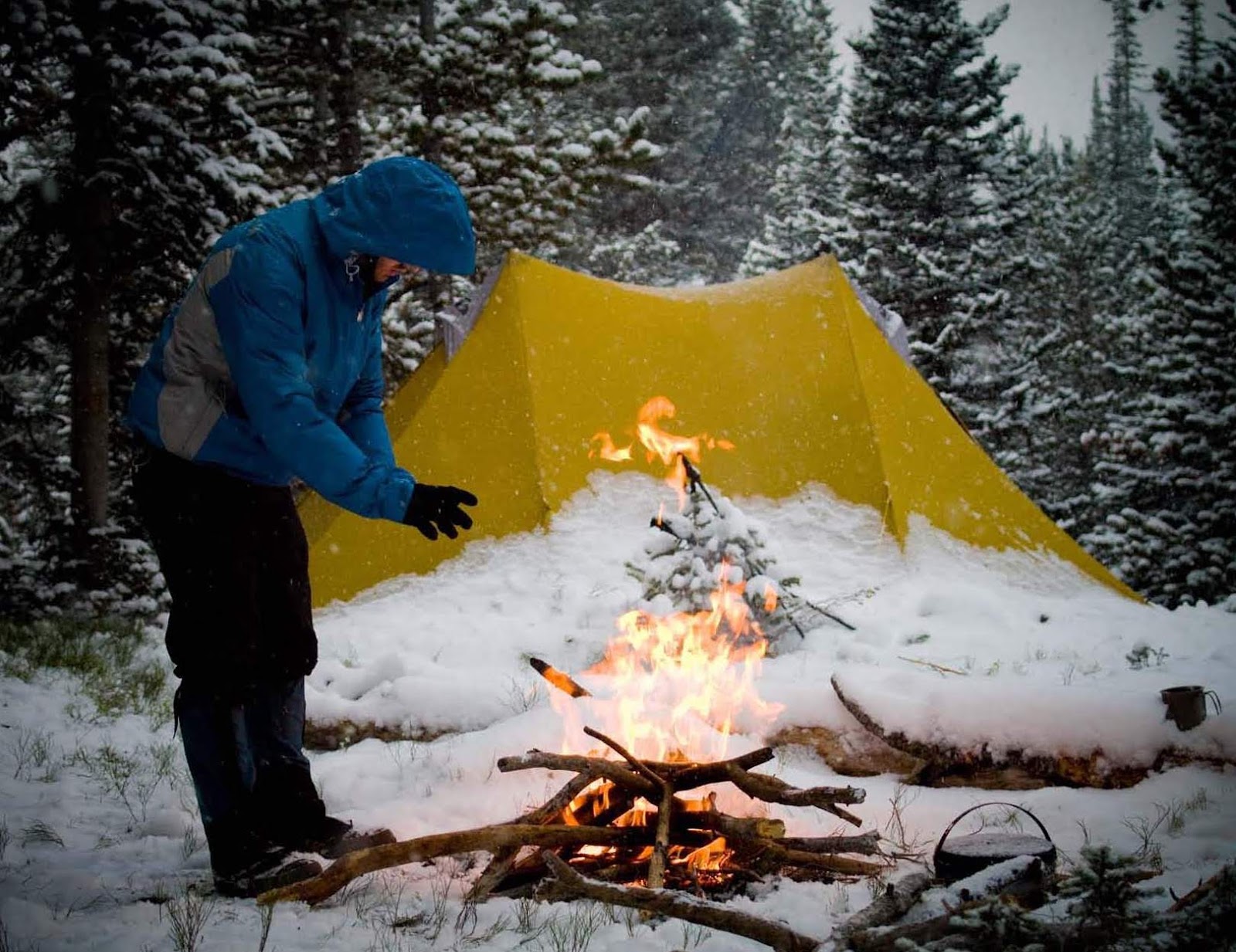
More Winter Inspiration: Trips
- Places / Video: Winter Backpacking in Southeast Wyoming
- Places: Winter Backpacking on the Ozark Trail
- Places: Skiing the John Muir Trail
- Places: A Winter Wasatch Overnighter
- Places: Curry and Fire
- Member Trip Reports: A Winter Overnight Bivy in the Sherman Range
More Forum Discussions about Winter Backpacking
- Solo winter backpacking?
- Water bottles for winter
- Pack weights for winter backpacking
- Pulks/sleds for winter backpacking
- Where are warm places to hike during the winter months?
- What to bring day hiking in the winter?
Search and Discovery
- Discover more winter-related content using our search tools.
- Browse the Winter and Snow Gear category in our Category Browser to find more articles, Member Gear Swap listings (classified ads for used gear), Member Gear Reviews, and more.
- Search the forums for all threads about winter.
- Browse our curated recommendations for winter gear in the Backpacking Light Gear Shop. The Gear Shop is a product research & discovery tool to explore Member gear reviews, Gear Swap (used gear) listings, and more info about specific products recommended by our staff and members.
- Find snowshoes, tents, skis, and more winter gear on sale using our Gear Finder search engine.
Help us maintain this page
If you found value in other related resources at Backpacking Light that you’d like to share with our community, please post them in the comments section below. No external links or resources, please – this trailhead is designed to be an index of content at Backpacking Light.
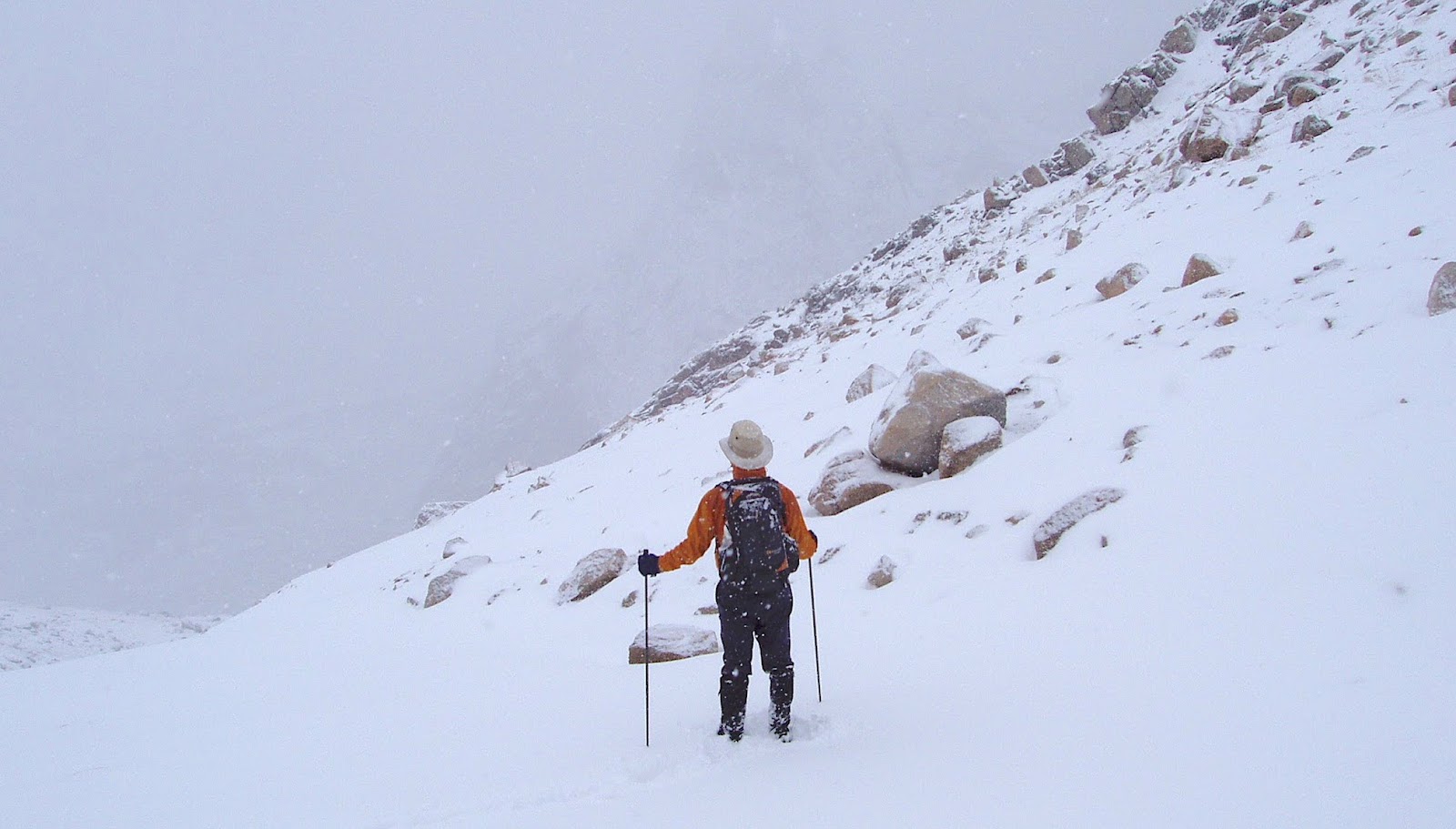
DISCLOSURE (Updated April 9, 2024)
- Product mentions in this article are made by the author with no compensation in return. In addition, Backpacking Light does not accept compensation or donated/discounted products in exchange for product mentions or placements in editorial coverage. Some (but not all) of the links in this review may be affiliate links. If you click on one of these links and visit one of our affiliate partners (usually a retailer site), and subsequently place an order with that retailer, we receive a commission on your entire order, which varies between 3% and 15% of the purchase price. Affiliate commissions represent less than 15% of Backpacking Light's gross revenue. More than 70% of our revenue comes from Membership Fees. So if you'd really like to support our work, don't buy gear you don't need - support our consumer advocacy work and become a Member instead. Learn more about affiliate commissions, influencer marketing, and our consumer advocacy work by reading our article Stop wasting money on gear.

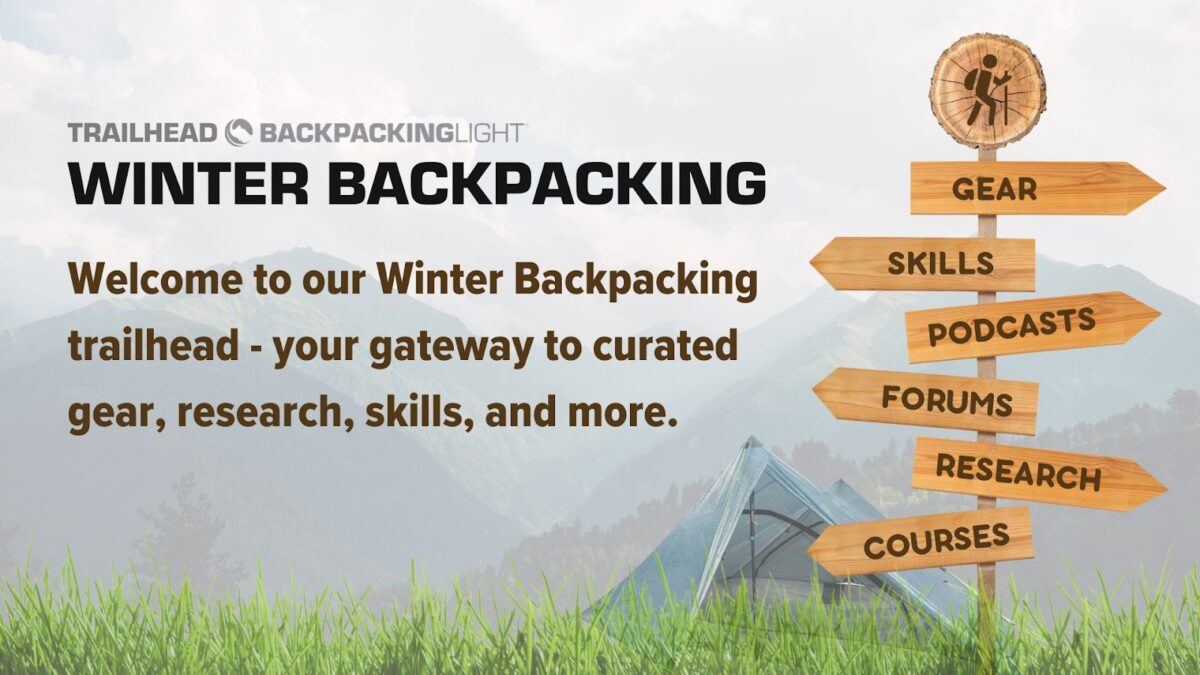


Home › Forums › Winter Backpacking Trailhead